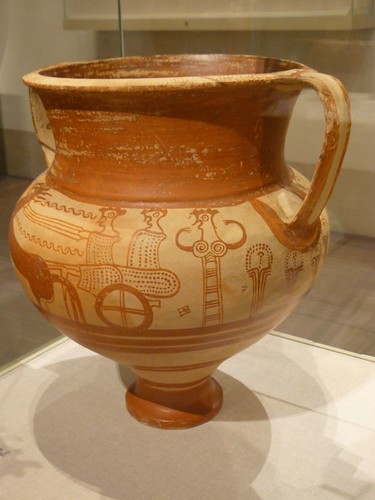The unknown vase looks pretty tough to decipher which culture it came from but there are some characteristics of it which help move me in a particular direction. At first glance, it appears to have been made on a potter’s wheel, but all three cultures did that as well. The first culture I would exclude this from being is the Cycladic people. Based on the Kamares Ware jug on page 86, the designs are pretty different; the vase is depicting specific things with registers while the Kamares jug looks to be pretty abstract and simplified like Cycladic artwork. The Minoan culture could have made this based on the idea that it does depict nature in a way. I shy away from this though, taking a look at the Harvester Rhyton on page 89, it becomes clear that the Minoans use realistic depictions of people and show depth. This vase appears to be more in the form of cartoonish characters and everything is single file. This leaves me to believe that this vase is the work of the Mycenaean people. Bringing up the Warrior Krater on page 99, I can see some distinct similarities between the two. First, both use distinct registers at the top and bottom of the vase, although this seems to be pretty common amongst Aegean art. Although the vase does not depict a wartime scene like the Mycenaean tended to be, it seems to show more of a farming type scene. Being that the Mycenaean were based on mainland Greece, it does not seem odd that they could have been farmers too. Another point in relation to the Warrior Krater is the depiction of images with no depth, and in profile similar to how the soldiers have no depth. The images in the farm vase also seem to have a cartoonish outline to them, similar to the style of the soldiers in the Warrior Krater. Although it would be hard to pick, I would say the Mycenaean would be most likely to have created this vase.
The second image of the fisherman is also tough to place. Firstly all three Aegean cultures could have a relation with water in some way so geographically I so no help. Going down the list, I would first eliminate the Cycladic again based on the fact that this image looks to be more complex than most works such as the Figure of a Woman on page 82. Next I would exclude the Mycenaean due to the depiction of the human form. Using the Warrior Krater on page 99 as an example, humans are depicted non realistic and outlined while this image depicts a human more naturalistically. Based on that fact I would move onto the Minoans, who like the other two had a relation with water. I really would like to think that this is a Minoan piece based on a few things. It is every humanistic and Minoan work such as the Harvester Rhyton appears to be realistic. It also incorporates part of the natural work, with the fish and that is something the Minoans are known for. Another thing similar to the Minoans is the incorporation of fish which is a sea creater. The Minoans seem to incorporate a lot to do with the ocean. Using the Flotilla Fresco on page 92, there seems to be pretty big similarities in the depiction of humans and sea creates in this image.





I really appreciated how you compared the different cultures examples to the unknown works. As well as inserting the page numbers, it helped me a lot to visualize what your argument was to figure out where the unknown works came from.
ReplyDeleteThe fact that you posted the information that led you to your deductions was extremely helpful for me to understand the artwork itself. It supports the hypotheses that you make about the two works. I did notice that you did not compare the two works to each other, because it seemed that you noticed differences in the two that would not group them in the same culture.
ReplyDelete